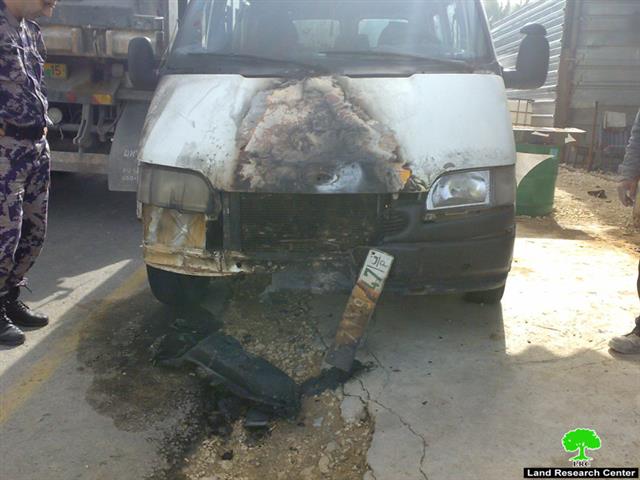Israeli Settlers’ attacks against residents of Kherbit Susya recorded high during the last couple of years as well as the Israeli Occupation Forces aggressive procedures. On the 19
th of January of 2011, the Israeli Occupation Authorities delivered demolition, evacuation and halt of construction orders to Al Jbour Family in Kherbit Susya. The evacuation order concluded that residents of susya are to evacuate 88
dunums of lands where the purpose of evacuation is not declared yet. It is worth mentioning that all the lands that are targeted by the evacuation order, their owners have original ownership documents or what is known by ‘the Turkish Ottoman ‘Tabo’.
Photo 1: a map associted with the evacuation order
Source: Land Research Center – Jerusalem 2011
Furthermore, many water wells, ‘toilets’, tents, and caves were demolished during the previous years. Many of these demolished properties were funded by different Palestinian agencies; such as the Union of Agricultural Work Committees in Susiya which funded the construction of water wells; and the toilet units (WC) were funded by the Palestinian Hydrology Group and are owned by Mohammad and Fawziyya An Nawaj’a. In Addition, Khirbet Susiya residents witnessed the confiscation of their lands for the sake of the nearby Israeli settlement of Susya where on the 9th of December 2009, the Israeli settlers accompanied by Israeli occupation army opened a dirt road southeast of Khirbit Susiya. Residents reported that the construction of the road is part of the Israeli Occupation plan for controlling thousands of dunums in the area marked as ‘Security Zone’. The Israeli Occupation Authorities announced assuming control over thousands of dunums and distributed maps showing the ‘Security Zone’
area and forbade the locals from grazing or planting in the area.

Map 2: a map showing the ‘security zone‘
Source: Land Research Center – Jerusalem 2011
In 1999 and 2001
, the Israeli Occupation Forces prohibited residents of Kherbit Susiya from the main source of life, Water as a further step to voluntarily displace them from the area. The Israeli Occupation Forces demolished the majority of the rain-catching water cisterns, which the local Palestinian farmers of Khirbet Susiya depended on to sustain life and work.
One of the local Palestinians reported to Amnesty International: ‘Water is life; without water we can’t live; not us, not the animals, nor the plants. Before we had some water, but after the army destroyed everything we have to bring water from far away; it is very difficult and expensive. They make our life very difficult, to make us leave’. While the Israeli settlement of Susiya is supplied with electricity power network and piped water from Israel, Palestinians depend on water wells and solar panels and wind turbine energy to survive.
Dozens of local Palestinian families have been expelled to make way for the archeological park.
On the 18
th of September of 1999, the Israeli settlement witnessed a major expansion on the expense of the kherbit’s lands, where 150 dunums were confiscated from the northern and eastern boundaries of the settlement.
Palestinians living in Kherbit susiya live in tents on a small rocky hill between the settlement and the archeological park. Ten caves inhabited by Susiya Palestinian families were blown up by the Israeli Occupation Forces in 1996, and some 113 tents were destroyed in 1998
The Israeli Occupation Authorities classify those Palestinians in the military orders as ‘Intruders’, asking them to evacuate and leave the area that they are using it for residential purposes.
Susiya illegal settlement
The illegal Israeli Settlement of Susiya was established in 1983, over 953 dunums of Yatta lands. Today, the settlement has a population of 792 settlers. The settlement is surrounded by Palestinian communities and Israeli settlements. From the north, it is bordered by Khirbet Susiya and Khirbet Shu’ab Al Bottom; from the south, it is bordered by Beit Yattir Settlement (Mezadot Yehuda), Khirbet Beir Al I’ed, Khirbet Mniezel and Khirbet Al Nabi; from the southeast, the Israeli outpost of Magen David (Ya’ier Farm); from the west, As Samu’ Village, Giv’at Ha Deigel outpost, Susya North Outpost and Susya West outpost; and from the east, it is bordered by Kherbit At Tawameen.
To conclude,
What happens in Khirbet Susiya and in the remaining Palestinian communities in the occupied Palestinian territory is considered illegal by International Law and Human Rights conventions, mainly the Fouth Geneva Convention of 1949 which states:
-
Art. 53: ‘Any destruction by the Occupying Power of real or personal property belonging individually or collectively to private persons, or to the State, or to other public authorities, or to social or cooperative organizations, is prohibited, except where such destruction is rendered absolutely necessary by military operations‘.
-
Art. 49: ‘Individual or mass forcible transfers, as well as deportations of protected persons from occupied territory to the territory of the Occupying Power or to that of any other country, occupied or not, are prohibited, regardless of their motive‘.
:::::::::::::::__
















